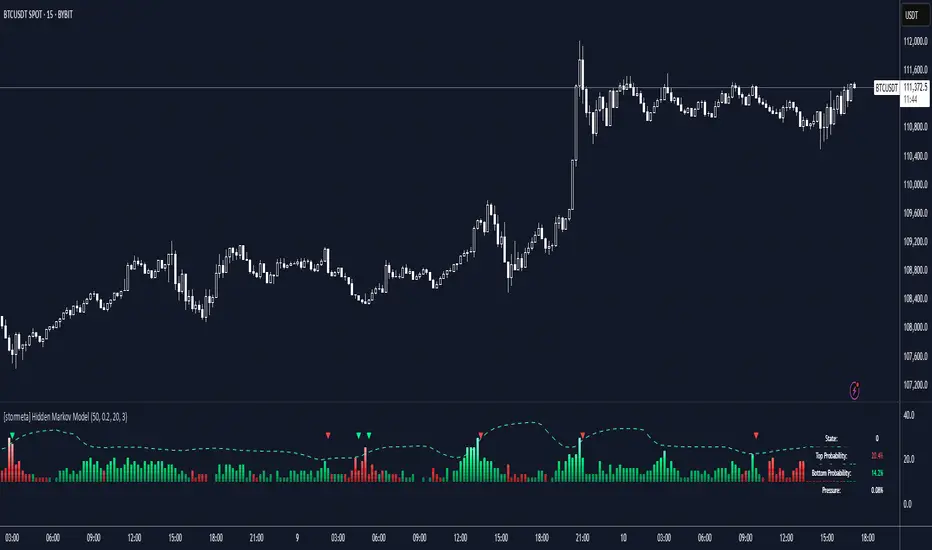OPEN-SOURCE SCRIPT
已更新 Hidden Markov Model

Overview
This model uses a Hidden Markov Model to identify and predict market regimes in real-time. It is designed to probabilistically identify market regime changes and predict potential reversal point using a forward algorithm to calculate the probability of a state.
Unlike traditional technical indicators that rely on price patterns or moving averages, this HMM analyses the underlying statistical structure of market movements to detect when the market transitions between different behavioural states such as trending, ranging, or volatile periods
How it works
The HMM assumes that market behavior follows hidden states that aren't directly observable, but can be inferred from observable market data (emissions). The model uses a (somewhat simplified) Bayesian inference to estimate these probabilities.
State 0: (Normal Trading): Market continuation patterns, balanced buying/selling
State 1: (Top Formation): Exhaustion patterns at price highs
State 2: (Bottom Formation): Capitulation patterns at price lows
How to use
1) Identify the trend (you can also use it counter-trend)
2) For longing, look for a green arrow. The probability values should be red. For shorting, look for a red arrow. The probability values should be green
3) For added confluence, look for high probability values of above 25%.
Advantages and what makes it unique
Unlike moving averages or oscillators that react to price changes, the HMM proactively identifies the underlying market structure. This forward-looking approach can signal regime changes before they become apparent in price action, providing traders with an informational edge.
This model uses a Hidden Markov Model to identify and predict market regimes in real-time. It is designed to probabilistically identify market regime changes and predict potential reversal point using a forward algorithm to calculate the probability of a state.
Unlike traditional technical indicators that rely on price patterns or moving averages, this HMM analyses the underlying statistical structure of market movements to detect when the market transitions between different behavioural states such as trending, ranging, or volatile periods
How it works
The HMM assumes that market behavior follows hidden states that aren't directly observable, but can be inferred from observable market data (emissions). The model uses a (somewhat simplified) Bayesian inference to estimate these probabilities.
State 0: (Normal Trading): Market continuation patterns, balanced buying/selling
State 1: (Top Formation): Exhaustion patterns at price highs
State 2: (Bottom Formation): Capitulation patterns at price lows
How to use
1) Identify the trend (you can also use it counter-trend)
2) For longing, look for a green arrow. The probability values should be red. For shorting, look for a red arrow. The probability values should be green
3) For added confluence, look for high probability values of above 25%.
Advantages and what makes it unique
Unlike moving averages or oscillators that react to price changes, the HMM proactively identifies the underlying market structure. This forward-looking approach can signal regime changes before they become apparent in price action, providing traders with an informational edge.
發行說明
Mathematical Functionsmath.log() - Used to calculate logarithmic returns for price analysis, which normalizes price changes and makes them more statistically workable.
math.abs() - Used to get absolute values for return magnitude, price velocity calculations, and deviation measurements.
math.min() - Used in adaptive learning to cap maximum values when updating transition probabilities.
math.max() - Used in adaptive learning to set minimum bounds when updating transition probabilities.
math.floor() - Used to convert probability percentages into discrete row counts for the visual probability display.
Technical Analysis Functions
ta.highest() - Used in the normalize_price function to find the highest price over a lookback period for price normalization.
ta.lowest() - Used in the normalize_price function to find the lowest price over a lookback period for price normalization.
ta.sma() - Used to create moving averages of recent volatility for comparison in emission probability calculations and learning algorithms.
ta.stdev() - Used to calculate standard deviation of signal strength for outlier threshold detection.
ta.ema() - Used to smooth the outlier detection line, providing a more responsive moving average than SMA.
ta.crossunder() - Used to detect when probability values cross below the outlier detection line for generating signal alerts.
Utility Functions
str.tostring() - Used to format numerical values for display in the information table.
table.new() - Used to create the information display table showing current state and probabilities.
table.cell() - Used to populate individual cells in the information table with formatted data.
table.clear() - Used to clear table contents before updating with new values.
Plotting Functions
plotshape() - Used extensively to create the visual probability columns (colored squares) and signal arrows.
plot() - Used to display the outlier detection line on the chart.
hline() - Used to create transparent boundary lines at the top and bottom of the indicator.
Alert Functions
alert() - Used to generate trading alerts when confirmed top or bottom signals are detected.
開源腳本
秉持TradingView一貫精神,這個腳本的創作者將其設為開源,以便交易者檢視並驗證其功能。向作者致敬!您可以免費使用此腳本,但請注意,重新發佈代碼需遵守我們的社群規範。
免責聲明
這些資訊和出版物並非旨在提供,也不構成TradingView提供或認可的任何形式的財務、投資、交易或其他類型的建議或推薦。請閱讀使用條款以了解更多資訊。
開源腳本
秉持TradingView一貫精神,這個腳本的創作者將其設為開源,以便交易者檢視並驗證其功能。向作者致敬!您可以免費使用此腳本,但請注意,重新發佈代碼需遵守我們的社群規範。
免責聲明
這些資訊和出版物並非旨在提供,也不構成TradingView提供或認可的任何形式的財務、投資、交易或其他類型的建議或推薦。請閱讀使用條款以了解更多資訊。